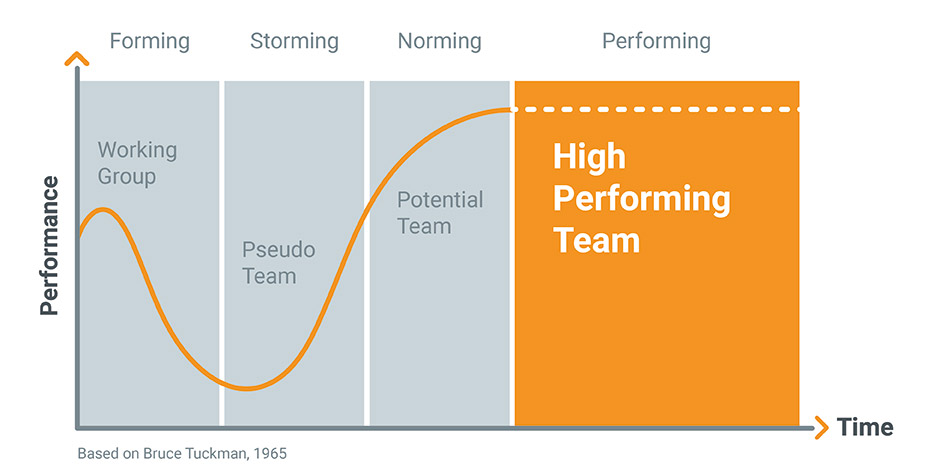Get in touch
A company that wants to introduce agile processes and working methods must start the transformation process at the very top of the hierarchy ladder. Especially at this level, the “cultural” attitude applies: “How I think influences my attitude and I act accordingly!” This is then followed by the creation of fundamental structures before specific methods such as Scrum (a model for project- and product management, especially for software development) can be introduced. In this second post of our three-part series we will deal with the differences between agile and traditional organizations, the prerequisites necessary for agility and a model for the development of high-performance, agile teams.
The most important prerequisite for an agile culture is trust. Agility can only work if a company, especially the management or executive board, places trust in its employees and relinquishes decision-making power and control. But why give up control at all? Why use agility at all?
The answer lies in the increasing complexity that permeates all areas of daily life and the business world. In today's economic environment, companies must be accessible 24 hours a day, from any location and through any channel. Mobile availability, omnichannel offerings and multiple touchpoints along the customer journey significantly increase this complexity. It is therefore also not manageable with knowledge, experience and seniority because these - and many other factors - play a role in overcoming challenges in business and in the daily cooperation with customers. These other factors include the people, the systems used and the markets in which companies operate. It is not possible to foresee all the details, both in the modern business world and at the beginning of a project, as many requirements are still unknown and are constantly changing. And, as we are currently experiencing, even the most well-thought-out plans, strategies and business models cannot account for such unpredictable crises such as Corona, especially when taking its global scope into consideration.
It therefore goes without saying – with or without Corona – that a flexible, step-by-step response to change is essential for success. Agility makes it possible to create value for the customer at an early stage; unforeseen changes are expected and are therefore considered from the outset. For example, to ensure that software projects do not fail due to complexity, the development of a product or solution is divided into numerous smaller iterations (releases). Errors are detected early on and can be corrected more easily and cost-effectively than if the solution is first developed completely and only then put into operation.
Agile organizations differ significantly from traditional companies. The main differences between agile organizations and traditionally structured companies:
If one knows and understands the differences between agile and traditionally structured companies, the three cornerstones that must be in place for a successful agile corporate strategy can be defined:

Once all necessary prerequisites are in place, it is possible to start building high-performance, agile teams. They are the key to successful agile work. Lone wolves working in isolation do not lead to success in the long run.
Ideally, these teams consist of people with a high degree of cross-functional expertise who work closely together to develop new business model- and/or business process concepts and who are much more efficient than the single, isolated expert in jointly implementing solutions, products or software.
In order for these teams to function well and deliver their performance on a continuous basis, they must be optimally structured. A functioning team with the necessary professional competence and agile methodological skills is essential, especially for complex projects. These competencies can be applied to all areas of the company - workflows, work and organizational structures and corporate culture, to name just the most important. To get an idea of the life cycle an agile team goes through, it is worth taking a look at the Tuckman phase model. The model describes the four stages that are important in building agile teams (Fig. 1):

Thus, it cannot be expected that a team will reach maximum performance right at the beginning – or shortly thereafter. In most cases, a team needs about two to three months to reach a basic level of performance. However, depending on the scope of a project, this period can also take up to half a year. However, it is possible to shorten the first two to three phases in particular with the help of an agile culture suitable for the company and sensible agile organizational structures and processes.
In the final installment of the blog series, we will take a look at the importance of customers for the agile process, examine another practical example of agility at work and explain why the introduction of agile working methods is actually very easy – and doesn’t hurt at all.
Further insights into the topic and how agility can be implemented in companies can be found in parts one and three of this blog series:
This blog post is an excerpt of the article “So geht agil: Ein Bauplan für jedes Unternehmen”, which originally appeared in German on ibusiness.